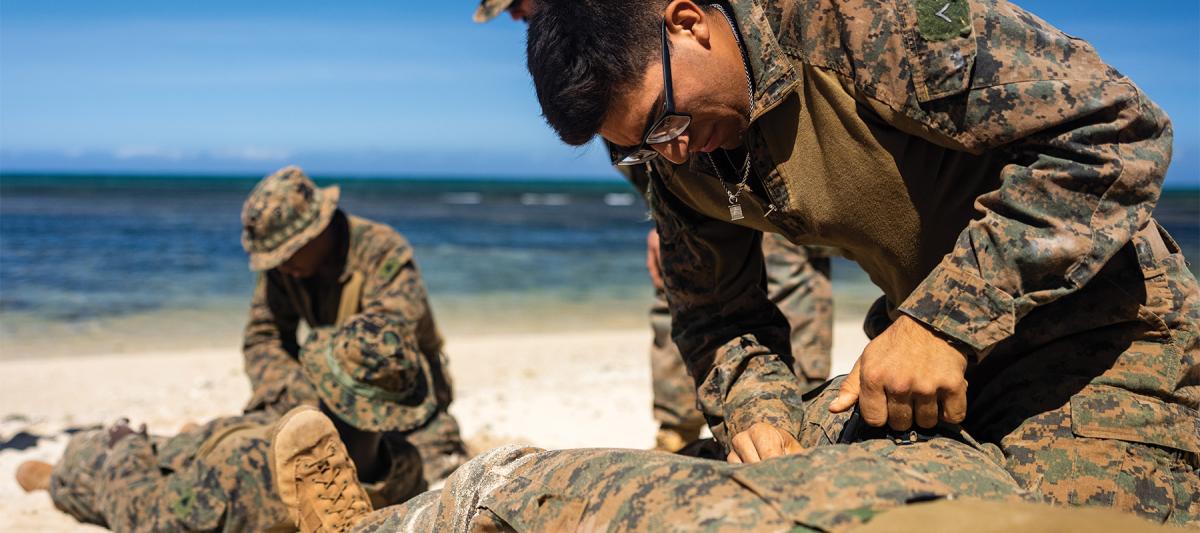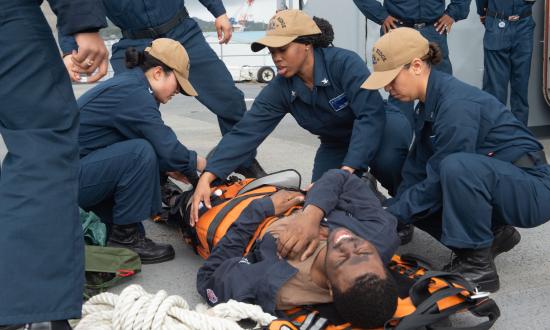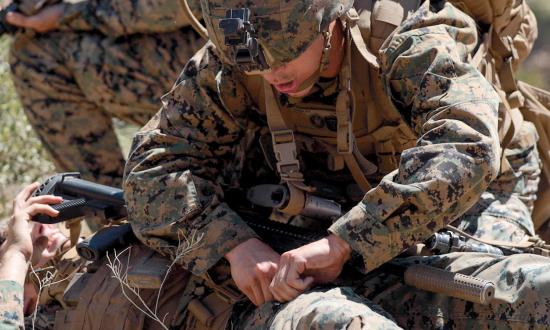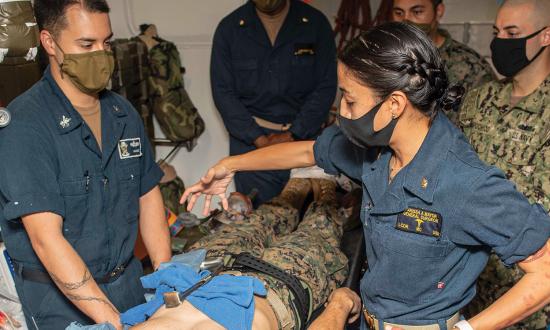Implementing expeditionary advanced base operations (EABO) requires an adaptive and mobile warfighting unit that can adjust to both environmental and enemy challenges in austere settings with limited resources. Therefore, the Marine Corps has placed increased emphasis on exercises that ensure tactical capabilities meet EABO requirements. This includes finding and engaging targets and—perhaps more important—sustaining the fight from remote locations. Among other things, sustainment requires proper medical care.
Environmental afflictions (such as frostbite or heatstroke), infection from poor wilderness hygiene, and the limited ability to manage battlefield injuries in contested positions all threaten success, even for the most lethal unit. To overcome these challenges, medical intervention capabilities must meet the same EABO standards to which all tactical capabilities are trained. The following lessons come from my time as a medical provider in a newly formed experimental Marine Corps battalion focused on addressing the EABO challenge through participation in Arctic Serpent 2023 in Norway and UNITAS 2023 in Colombia.
Operating in Remote and Harsh Environments
Preventing and treating environmental injuries is a critical consideration when units are deployed under the EABO framework. Time spent with allied militaries in different climates revealed the need for cooling techniques for heat-related illness (such as heat exhaustion and heatstroke) and warming strategies for hypothermia and frostbite. Understanding heat transfer—radiation, convection, conduction, and evaporation—informs how best to pack and prepare for these deployments while remaining light and mobile. For instance, wetting and fanning a heat casualty induces evaporative cooling that has a similar effect to using icepacks, but without the icebox and transport considerations that icepacks require. Changing a cold-weather casualty into dry clothes and using the body’s natural heat conduction with blankets and base layers can prevent the need for more invasive warming techniques and hypothermia protocols. Cold-weather countries also use vapor barriers when outdoors for extended periods, such as wrapping feet in plastic bags to prevent moisture transfer that can lead to frostbite.
When stealth and mobility are of utmost importance and timely evacuation is unlikely, planning the medical logistics to operate in an EAB environment is vital to force sustainment. If a casualty needs blood, a walking blood bank is favored over transported blood because of the temperature-control measures the latter requires. Medications can freeze, so cold-weather medics keep theirs taped to their bodies. Antibiotics should be abundantly supplied and freely given, since extended time in bivouac presents ample opportunity for insect bites and nonpotable water to become sources of bacterial infection that can severely limit troop function.
EABO casualty evacuation requires a significant shift in approach from what the services practiced in Iraq and Afghanistan. With U.S. air superiority in those conflicts, casualty evacuation guidelines stressed the “golden hour,” in which transfer to definitive surgical care within an hour greatly improved casualty outcomes. In future wars, neither air superiority nor casualty evacuation within the golden hour are guaranteed.
Instead, forward units will need experience providing prolonged casualty care until evacuation is possible. Furthermore, advances in remote surveillance and targeting make the large footprint of a full Role 2 medical setup (which includes an operating room) vulnerable to enemy detection, not to mention how the transport and supply demands of such an outfit restrict the flexibility favored by the EABO approach. Currently, a novel approach to field medical care using damage control resuscitation (DCR) teams is being piloted with the Marine Corps as a potential solution.
Consisting of an emergency medicine physician, a trauma or critical care nurse, and six corpsmen, a DCR team is equipped to move forward and receive casualties close to the point of injury to begin resuscitation. As forces push toward enemy lines, this eight-person team offers the highest capability medical response with the smallest footprint. In training exercises, the DCR team functioned using supplies from one or two small shipping containers and established a two- to four-bed emergency room in 20 minutes. If the emergency room needs to be farther forward than the shipping containers allow, utility terrain vehicles (UTVs) are used to transport supplies from the shipping containers to the emergency room. UTVs also can be outfitted with oxygen-delivery and monitoring devices to swiftly transport casualties from point of injury to the emergency room as needed.
Remaining Obstacles
Despite these advances in forward-deployed medical care, there are still limitations to address. Lack of an available surgeon limits the capacity for life-saving interventions for certain injuries, such as intra-abdominal penetrating wounds. Even with the significant reduction in footprint, establishing a formal emergency room and requiring small shipping containers for supplies may not be feasible in certain situations. And having to provide prolonged casualty care in a low-resource environment when blood, medications, and oxygen are all limited challenges the ability to keep a casualty alive. These issues merit further experimentation.
New triage techniques are being adapted to identify which casualties a DCR team can adequately care for and which will need priority evacuation (when possible) for early surgical intervention. In situations that may not allow for shipping containers and an emergency room, “provider bags” are being adopted from doctors attached to special operations units who carry everything needed to provide resuscitative care. Finally, tactical resupply vehicles (TRVs) are being considered for their potential to restock blood, fluids, and medications during prolonged casualty care.
Expeditionary warfare places a premium on units that can function effectively despite the environmental and logistical challenges of operating in the contested and austere settings of EABO. The unique medical limitations in these environments could potentially neutralize even the most advanced tactical groups. Solutions, such as augmenting casualty care with UTVs and TRVs and using low-resource interventions for weather-related injuries, should be tested in targeted training scenarios and discussed with allies. EABO will require the Marine Corps adopt better logistical processes for medical mobility and preparedness.






